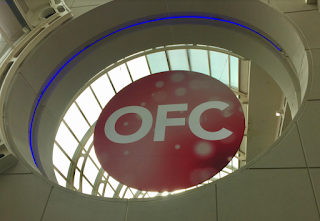This week at OFC in San Diego, the Optical Internetworking Forum (OIF) is conducting a series of multi-vendor interoperability demonstrations showFlexE), 112 Gbps per lane live electrical signaling and end-to-end optical links using CEI-56G-VSR electrical interfaces.
casing three significant technologies; Flex Ethernet (
There are 14 participating companies including Amphenol, Credo Semiconductor, Fiberhome Telecommunications Technologies Co., Ltd., Finisar, Huawei Technologies Co., Inphi, Keysight Technologies, Molex, TE Connectivity, Tektronix, VIAVI Solutions, Xilinx, Yamaichi Electronics, and ZTE Corporation.
Flex Ethernet Demo -- the FlexE technology from the OIF extends standard Ethernet with bonding, subrating, and channelization features and is defined in the FlexE v1.0 Implementation Agreement. The demo features interoperability among member companies using combinations of these three features over multiple types of 100 GbE.
56 Gbps Demo -- this demo features multiple silicon suppliers operating over a 56 Gbps PAM4 VSR (chip to module) link reflecting the recently published CEI 4.0 document that includes this 56 Gbps PAM4 channel definition. The 56 Gbps demo will electrically drive interoperating optical modules, interconnected with fiber, showing a full multi-vendor electrical-optical-electrical link from host-to-host. The broad range of technologies and suppliers participating in the demo indicates the maturing industry ecosystem around 56 Gbps signaling.
112 Gbps Demo -- the OIF recently began new projects to define 112 Gbps per lane interoperable serial electrical channel definitions. As part of that effort, the OIF will be presenting two 112 Gbps serial electrical demos at OFC 2018. The first demo will include a silicon chip driving a VSR (chip to module) channel and the second will have a silicon chip driving a direct attach copper cable assembly. 112 Gbps electrical signaling is regarded as a necessary technology to enable future signaling bandwidth requirements.
“The OIF continues to test and validate the implementation agreements the forum is working on or has recently completed,” said Steve Sekel of Keysight Technologies, Inc. and the OIF’s Physical and Link Layer Interoperability Working Group Chair. “The OIF recently published both CEI revision 4.0 which includes CEI-56 Gbps requirements and the FlexE revision 1.0 specification. The forum also started work on four CEI-112 Gbps projects so this demo provides important insight into the potential technical solutions.”
casing three significant technologies; Flex Ethernet (
There are 14 participating companies including Amphenol, Credo Semiconductor, Fiberhome Telecommunications Technologies Co., Ltd., Finisar, Huawei Technologies Co., Inphi, Keysight Technologies, Molex, TE Connectivity, Tektronix, VIAVI Solutions, Xilinx, Yamaichi Electronics, and ZTE Corporation.
Flex Ethernet Demo -- the FlexE technology from the OIF extends standard Ethernet with bonding, subrating, and channelization features and is defined in the FlexE v1.0 Implementation Agreement. The demo features interoperability among member companies using combinations of these three features over multiple types of 100 GbE.
56 Gbps Demo -- this demo features multiple silicon suppliers operating over a 56 Gbps PAM4 VSR (chip to module) link reflecting the recently published CEI 4.0 document that includes this 56 Gbps PAM4 channel definition. The 56 Gbps demo will electrically drive interoperating optical modules, interconnected with fiber, showing a full multi-vendor electrical-optical-electrical link from host-to-host. The broad range of technologies and suppliers participating in the demo indicates the maturing industry ecosystem around 56 Gbps signaling.
112 Gbps Demo -- the OIF recently began new projects to define 112 Gbps per lane interoperable serial electrical channel definitions. As part of that effort, the OIF will be presenting two 112 Gbps serial electrical demos at OFC 2018. The first demo will include a silicon chip driving a VSR (chip to module) channel and the second will have a silicon chip driving a direct attach copper cable assembly. 112 Gbps electrical signaling is regarded as a necessary technology to enable future signaling bandwidth requirements.
“The OIF continues to test and validate the implementation agreements the forum is working on or has recently completed,” said Steve Sekel of Keysight Technologies, Inc. and the OIF’s Physical and Link Layer Interoperability Working Group Chair. “The OIF recently published both CEI revision 4.0 which includes CEI-56 Gbps requirements and the FlexE revision 1.0 specification. The forum also started work on four CEI-112 Gbps projects so this demo provides important insight into the potential technical solutions.”





















